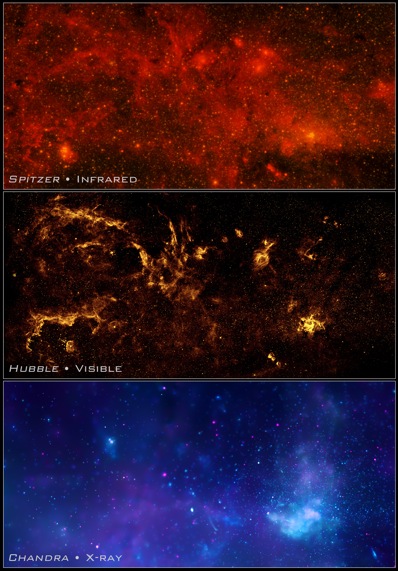



|

|

The turbulent heart of
the Milky Way
DR EMILY BALDWIN
ASTRONOMY NOW
Posted: November 11, 2009


In celebration of the International Year of Astronomy, NASA is releasing a never-before-seen vista of the turbulent heart of our Milky Way Galaxy to planetaria, museums, libraries, nature centres and schools across America.
 A trio of images from Spitzer (top), Hubble (middle) and Chandra (bottom) exposes a wealth of exotic objects buried deep in the heart of the Milky Way. Image: NASA, ESA, SSC, CXC, and STScI. A trio of images from Spitzer (top), Hubble (middle) and Chandra (bottom) exposes a wealth of exotic objects buried deep in the heart of the Milky Way. Image: NASA, ESA, SSC, CXC, and STScI.
These sites will unveil a giant six foot by three foot print that combines near infrared views from the Hubble Space Telescope, an infrared view from the Spitzer Space Telescope, and an X-ray view from the Chandra X-ray Observatory. The mosaic provides one of the most detailed views ever of the Galaxy's chaotic core.
The panorama captures snapshots of vigorous stellar birth, through young hot stars and cool old stars, to the violent explosions of stars reaching the ends of their lives. This activity plays out against a backdrop of a supermassive black hole – nearly four million times more massive than our Sun.
 Combining the images reveals this colourful portrait of activity in the Milky Way's core. Yellow colours represent Hubble observations, red from Spitzer and blue-violet from Chandra. The bright blue blob on the left is from a double star system containing either a neutron star or a black hole. Image: NASA, ESA, SSC, CXC, and STScI. Combining the images reveals this colourful portrait of activity in the Milky Way's core. Yellow colours represent Hubble observations, red from Spitzer and blue-violet from Chandra. The bright blue blob on the left is from a double star system containing either a neutron star or a black hole. Image: NASA, ESA, SSC, CXC, and STScI.
Chandra's X-ray vision reveals the diffuse blue haze of X-ray light from gas heated to millions of degrees by outflows from the black hole, marked by the bright region to the lower right, and from the winds of massive stars. In the image, pink represents lower energy X-rays while blue indicates high energy. Infrared light picks out more than a hundred thousand stars and glowing dust clouds in the form of globules, filaments and pillars that cocoon embryonic stars.
The images will be unveiled at 152 institutions across the nation to celebrate 400 years since Galileo first turned his telescope to the skies.
|

|

|

|
|



